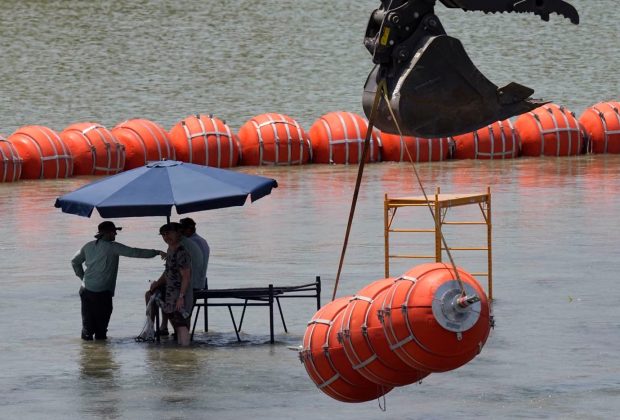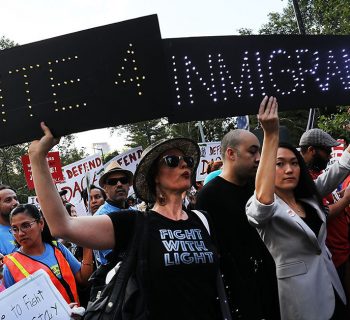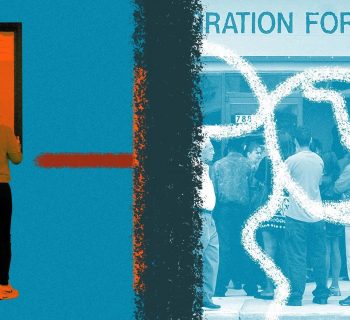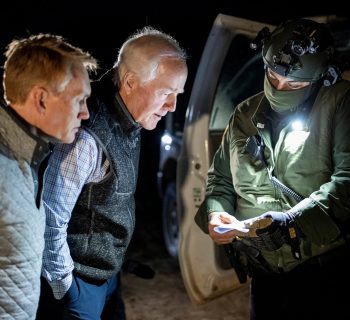Barrier installation continued despite U.S.-Mexico river agency’s demands for federal OK and proof that flooding wouldn’t get worse.
By Aaron Torres & Todd J. Gillman | The Dallas Morning News | AUG. 8, 2023 | Photo by Eric Gay
AUSTIN — Newly uncovered records show Texas officials ignored warnings that installing anti-migrant buoys in the Rio Grande and concertina wire along the banks violated federal law and a U.S. treaty with Mexico.
On March 29, a Texas Highway Patrol captain even asked the International Boundary Commission that controls the Rio Grande to help with a permit the city of El Paso refused to grant, to put electricity in a command trailer.
The commission declined, reminding the captain that the trailer — under a bridge in the floodplain — was on federal property without authorization.
“The State of Texas, operating through various entities, including but not limited to, the Texas Department of Public Safety (DPS) (and its contractors) does not have authorization for its presence on the federal property that is managed, owned, and/or controlled by the United States, International Boundary and Water Commission” or USIBWC, said the April 21 response.
Those warnings began in December, well before construction started on the controversial river barrier. Two migrants were found drowned near the barrier last week, sparking recriminations from Democrats and migrant advocates.
Officials from numerous state agencies were informed over at least seven months that Texas needed federal permission before intruding on federal land or installing barriers in or along the river.
Documents obtained from the border commission by The Dallas Morning News through an open records request show that DPS and other Texas entities were put on notice about federal permit and floodplain impact study requirements at least as far back as Dec. 21, and many times since then.
The commission “repeatedly made clear to Texas officials our concerns about their activities on territory under [its] jurisdiction,” and turned to the Justice Department for help when Texas kept ignoring its requests, spokesman Frank Fisher said Monday.
The Justice Department sued Texas last month, demanding removal of the floating barriers and seeking a court order barring any more unauthorized structures along or in the river. A hearing is scheduled for Aug. 22 to consider the Justice Department’s request to remove the structures while the lawsuit plays out.
The buoys, and Gov. Greg Abbott’s very public refusal to remove them, have drawn international condemnation.
The criticisms escalated last week after the drownings.
One migrant was stuck to the buoys. Mexican officials have not been able to identify him or say what country he came from. Steve McCraw, director of the Texas Department of Public Safety, said he likely died upstream and floated into the barrier where state troopers spotted the body.
A second victim, identified as a 20-year-old man from Honduras, was found about three miles upstream.
/cloudfront-us-east-1.images.arcpublishing.com/dmn/UXHEH4AEPNHB5E5W5IQOSUPQRE.jpg)
Abbott has been defiant, and the records show his underlings were well aware of permit requirements they were ignoring.
On Dec. 29, Capt. Rogelio Vargas of the Texas Army National Guard wrote the bureau commission’s security chief, Aaron Haynes, seeking guidance on how his troops could safely maintain the state’s “temporary fencing/anti-climb barrier.”
A Texas Department of Emergency Management contractor had installed it in the concrete channel of the Rio Grande, he wrote, and “we want to avoid making holes in the concrete to reduce the damage of structural integrity of the concrete channel.”
A U.S. official with the commission, Frankie Piñon, responded on Jan. 4. He asked for maps, specifications and statements giving sign-off from two federal agencies:
The U.S. Fish and Wildlife Service would have to waive any objections over potential impacts to threatened and endangered animals and plants. And the U.S. Army Corps of Engineers would have to determine the effects on U.S. waterways.
Texas bypassed both agencies — a key point of contention from the Justice Department and a point of pride for Abbott.
“Texas has the sovereign authority to defend our border, under the U.S. Constitution and the Texas Constitution,” the governor wrote President Joe Biden in response to the Justice Department’s threat to sue. “We will continue to deploy every strategy to protect Texans and Americans — and the migrants risking their lives. We will see you in court, Mr. President.”
Spokespeople for Abbott, DPS and the Texas Military Department did not respond to requests Monday for comment on the documents and emails.
On Tuesday, after this story was published, Abbott responded on social media with two critiques: “What this story doesn’t tell you is that I informed Biden almost a year ago about Texas’s constitutional authority to secure the border. It also ignores the fact that the bouys [sic] used by Texas did not cause the drowning of the 2 bodies.”
The story did not blame the drownings on the buoys, though migrant advocates have drawn that link.
Abbott has not previously asserted that Texas is free to ignore federal law as long as it warns the federal government first that it intends to do so.
A July 18 email from Vargas to the boundary commission implicitly acknowledged what Abbott has not: that the state does not have carte blanche at the border.
“I am trying to find out what are legal limitations to perform earthwork along the river’s edge of the Rio Grande River in Eagle Pass, Texas,” Vargas wrote.
Four hours later, a boundary commission official responded that permits are required for any work on land it owns along the river. And “regardless of land ownership, the [boundary commission] requires that hydraulic modeling must be done for work in the river or floodplain to determine if the proposed project will create a deflection or obstruction of the normal or flood flows of the river.”
In contrast to Vargas’ inquiry, Abbott has maintained that Texas has the “sovereign” right to protect its border regardless of any federal rules, on grounds that the federal government has not sufficiently secured the border against “invasion.”
‘Obstruction and deflection’
The buoys are the latest escalation in Abbott’s $10 billion state border security effort dubbed Operation Lone Star.
According to emails and letters, on Dec. 22, the Mexican Section of the boundary commission formally complained about the placement of more than 100 railway containers along the U.S. side of the river near El Paso.
Mexican officials warned that could “cause an obstruction and deflection of the Rio Grande flows.”
That would violate the 1970 Boundary Treaty, under which the U.S. and Mexico agreed to stabilize river flows and mitigate flooding by preventing obstructions or deflections.
Mexican officials also warned that if the large cargo containers came loose, they could cause damage or kill someone downstream — on top of the fact they were installed without permission.
On Jan. 11, the commission wrote to McCraw and Mike Novak of the Texas Facilities Commission, warning that Texas’ installations along the river violated the 1970 treaty.
“No unauthorized access shall be made onto USIBWC-controlled land and no infrastructure should be placed on any part of the floodplain without prior approval by the USIBWC including but not limited to, concertina wire, chain link fencing, storage containers, vehicles, concrete barriers, or any other objects that could cause deflection of water within the floodplain,” the commission wrote, adding that some of Texas’ activities had already damaged flood control structures.
“Any unauthorized access and any infrastructure installed, constructed, or otherwise placed on the floodplain may be considered an encroachment of federal property and …may require immediate removal,” the letter said.
On Jan. 23, the commission gave Texas officials until Jan. 31 to comply, demanding the issues be “addressed expeditiously” before spring flooding.
No secret, no permit
The deadline passed.
“Potential flooding in these areas may substantially increase the potential for damage to infrastructure and possibly loss of life such as from the containers placed along the riverbanks becoming dislodged or the bollard fence segments deflecting flow. Dislodged containers and other project elements also pose the risk of colliding with downstream structures such as international bridges in El Paso and Eagle Pass causing damage,” the commission wrote.
Although state agencies ignored demands to hold off on barrier installation until permits were issued, Texas agencies weren’t keeping their activities secret from federal authorities.
Emails show that on Dec. 21, Capt. Matthew Scales of the Texas Highway Patrol’s El Paso district met with the border commission’s Piñon.
Shortly afterward, Scales sent him a map showing where the state had put concertina wire and indicating where the next such installations might come.
Piñon emailed the next day, thanking him for “helping our team better understand this very dynamic situation unfolding at the international boundary here in El Paso.”
“We understand the challenges our law enforcement partners face daily, and we very much appreciate your service to our community,” he wrote, making it clear, though, that the commission still expected a formal permit process.
“We look forward to working with you and the State of Texas on reviewing plans and specifications for barrier infrastructure on the [border commission] Right of Way,” he wrote.
On Dec. 28, Scales told Piñon by email that the state had already added 10 more railroad containers.
“We have also extended our footprint east” past the Santa Fe Port of Entry, using portable fencing and razor wire, he wrote. “There are no plans at this time to continue to extend our footprint, but if anything changes I will let you know.”







